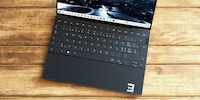

Asus Zenbook S 13 OLED review: thin, light, strong
Small, flat yet still suitable for presentations without adapter. The Asus Zenbook S 13 OLED. I discover many more tasty tidbits in my test, of course. Tidbits such as the Intel Core i7-1355U and the screen’s colour reproduction.
The Asus Zenbook S 13 OLED has been my companion for a good month and a half. However, I’m only now realising its best feature, besides the beautiful OLED panel, at an editorial meeting. I have to give a presentation and am asked if my notebook has an HDMI port. The boardroom demands it – and the ultra-thin notebook delivers. Any fellow adapter-hater knows how happy such a little thing can make you.

As for the Zenbook’s downsides, I’m unsure before testing. At most, the cooling could become problematic when the CPU is under permanent load. It has to contend with a relatively potent mobile i7 13th generation processor. And the super-thin notebook, weighing only one kilogram, has little room for cooling elements and fans.
Find out how loud, as well as hot, the Zenbook gets at the end of the article. This much in advance: when surfing, doing office work or playing movies, the fan isn’t audible at a normal sitting distance.
Hardware overview and design
Asus sells different versions of the Zenbook S 13 OLED depending on the country: with Intel or AMD CPUs, a normal touchpad or one that has an integrated number pad. There’s also variants with or without touchscreen and different ports (USB4 instead of Thunderbolt 4, with or without HDMI).
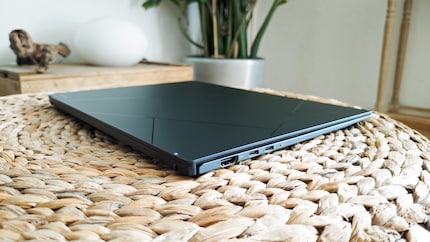
Source: Martin Jud
My test model features a CH keyboard layout. This one’s currently only available with an i7 Intel processor, normal touchpad and OLED without a touchscreen. However, it comes with two Thunderbolt 4 ports (USB-C, support for DisplayPort and Power Delivery), one USB 3.2 Gen 2 Type-A port, one HDMI 2.1 port and a 3.5 mm jack. The notebook isn’t charged via a separate power port, but via one of the two Thunderbolt 4 ports.
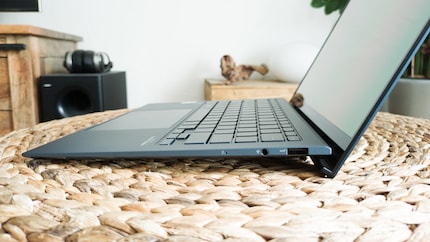
Source: Martin Jud
The case, only slightly over a centimetre thick, is made of aluminium and magnesium. When opening the display, the base automatically lifts a bit so that the keyboard is at a slight angle when typing. I really like this feature.
The specs of my «Ponder Blue» test device:
In addition to the powerful processor, generous storage and an OLED display primed for lengthy film sessions, the battery isn’t too tiny either. All this despite its small size.
OLED display: accurately reproduces DCI-P3, sRGB and Adobe RGB
The near-borderless OLED panel offers 2.8K resolution at 60 hertz, so it can’t display 4K videos natively. Nevertheless, its 255 pixels per inch deliver a razor-sharp image. In addition, there’s support for Dolby Vision and HDR 500, which displays corresponding video material with more detailed brightness gradations and a greater peak brightness after activating the HDR Windows setting. Together with the classic OLED black, this gives the picture a depth that’s unachievable with SDR videos.
The peak brightness with HDR content is supposed to reach up to 550 nits with this display. Unfortunately, I can’t verify this HDR peak brightness with my tools. However, my eyes are very happy with what the small display conjures up as a replacement TV on holiday evenings. The SDR peak brightness is supposedly 400 nits.
Brightness, uniformity and colour reproduction
I find out how bright the display is without HDR, how uniform the illumination and how accurate the colour representation is with a ColorChecker Display Plus from Calibrite.
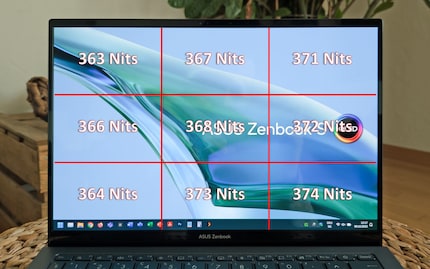
Source: Martin Jud
Typical for OLEDs, the display is very evenly illuminated. The largest deviation is only three per cent (11 nits), imperceptible without measuring devices. In addition to uniformity, I also measured the full frame brightness: 366 nits. I’m satisfied with a display starting at 300 nits, as I can work well inside with it in daylight. On the balcony, however, I’d prefer 400 nits, which the device isn’t far from.
Asus boasts 100% coverage of the DCI-P3 colour space, important in film production. I can both confirm this and praise the panel even further. In the Adobe RGB colour space, important for creating print templates, I don’t quite measure 100 per cent coverage – but at 98 per cent, it’s still an amazing value. The sRGB colour space, common for normal digital work and surfing, is also fully covered.
Keyboard and touchpad: tactile and quiet
The keyboard doesn’t have a number pad, but the keys are backlit and pleasantly big. The key spacing is the same as on usual desktop keyboards. Measured from the centre of the key to the next, it’s 19 millimetres.
When typing, I feel clear resistance right at the beginning of key travel, after that it’s like butter. The key stroke occurs at 1.4 millimetres. I quickly get used to this new feel when typing, although I prefer linear keys. The handiwork looks clean – if I wiggle the keys, they hardly budge.
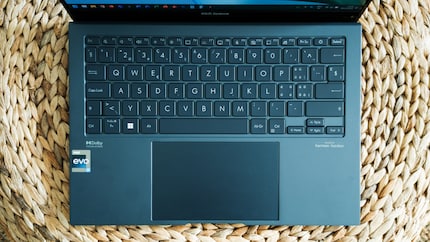
Source: Martin Jud
Since the keyboard remains very quiet, even if you really slam down your fingers, it’s also well suited for open-plan offices. The only thing that slightly bothers me is the backlight LEDs of some keys. Light shines through the keycaps earlier than others when viewed from a flat angle.
I have nothing negative to say about the touchpad. It’s big – 13 × 8 centimetres – and its surface is smooth, as I expect. Even sweaty fingers glide around it with pinpoint accuracy.
Loudspeakers: good sound for a notebook
The Dolby Atmos certified speakers are discreetly placed on the sides at touchpad height. I can only see the slits when I flip the notebook.
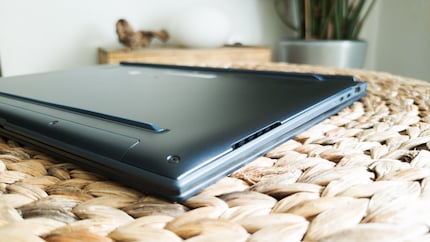
Source: Martin Jud
They provide a pleasant sound with good stereo effect. Voices in particular sound very clear, no matter the pitch. In movies and music, the highs, mids and upper lows usually seem balanced and energetic. However, the tiny speakers crumble with very low bass tones, typical for all smartphone and laptop speakers. All in all, I’d describe them as decent notebook speakers.
Processor performance: Cinebench and Geekbench
I test the processor with benchmarks from Cinebench and Geekbench. Two performance and eight efficiency cores with a total of twelve threads are included in the Zenbook’s Intel Core i7-1355U. The cores deliver up to 5 and 3.7 gigahertz respectively with Turbo on and can draw up to 55 watts.
Here’s how the Zenbook performed. For comparison, I’ll list the Lenovo Yoga 9i (2023), which uses the same processor. I’ll add the Acer Swift Go 14 with a slightly stronger CPU too, also a 13th generation Intel:
The results of the Acer Swift Go 14 are missing in Cinebench 2024 since the benchmark didn’t exist at time of testing.
In the Cinebench R23 and Geekbench 6 multi-core tests, the Acer Swift Go 14’s superiority clearly shows how much more performance 20 instead of 12 threads can unleash. With only four more cores and a 0.6 to 0.7 gigahertz higher clock rate, the Acer’s CPU manages about twice the performance. Provided that an app is programmed in such a way that this many cores can be utilised, it’s great. However, the aforementioned i7-13700H processor also draws more power – up to 115 watts.
Since the performance of mobile processors strongly depends on cooling, comparing the Zenbook to a competitor with the same chip is more interesting. In the Lenovo Yoga 9i, the Intel Core i7-1355U performs either just as well or worse, indicating that Asus has done a lot better with the Zenbook’s cooling.
The results also match my general feeling about the CPU. It never lets me down while I’m working. If I want to archive files or encode something, it’s faster than what I’m used to.
Graphics performance: 3DMark Night Raid (lowest level gaming)
3DMark Night Raid is designed to test the graphics performance of devices with an integrated GPU. It’s basically a performance meter for PC gaming at the lowest level. Integrated means that the graphics unit is bundled with the CPU on the system-on-a-chip (SoC) – the Intel Core i7-1355U. If you want more power, you need a dedicated graphics card.
The Intel Iris Xe graphics of the Zenbook has 69 execution units and clocks up to 1.3 gigahertz. It picks up a score of 14,519 in Night Raid, combined from a graphics score of 18,829 and a CPU score of 6,321.
According to 3DMark, this performance is slightly weaker than the average 2023 office laptop with an Intel Core i7-1360P (Night Raid score of 16,304). Since the i7-1360P is actually a bit stronger with two more performance cores and a graphics unit with 0.2 higher gigahertz, this fits. The Zenbook seems to deliver what’s expected from its SoC here as well.
As an average gaming laptop from 2023, 3DMark lists a device with an AMD Ryzen 9 7940HS and Nvidia RTX 4070 as a comparison. For this one, the Night Raid score is 49,992. Over three times the performance of my Zenbook.
Battery performance: 11 hours and 30 minutes in the Modern Office scenario
With PCMark 10 Professional Edition, the battery performance can be tested using various standardised scenarios. I tested the battery life with the Modern Office profile. This aims to cover «the common, everyday ways that people use a PC. The workloads include Web Browsing, Video Conferencing, and App Start-up time».
I start the battery benchmark with 100 per cent charge – the notebook shuts itself down at 3 per cent. After restarting, PCMark shows me the result: 11 h 30 min.
Eleven and a half hours roughly coincides with me having to recharge the notebook after about one and a half workdays on average. I’m fine with that.
Fan volume and heat development
During normal work that doesn’t strain the processor for a long time, I only hear the fan when I put my ear very close to it. It only becomes audible from a seated position when the notebook downloads and installs updates in the background, for example.
The cooling becomes really audible when I run the CPU benchmarks. I measure up to 36.3 decibels during the benchmarks with my Testo sound level meter from a sitting position. At a distance of 30 centimetres from the fan, I got 40.1 decibels, making the Zenbook one of the quieter notebooks I’ve tested. For example, it performs just as well as the Dell XPS 13 Plus, which is equally small but lugs around an extra 230 grammes.
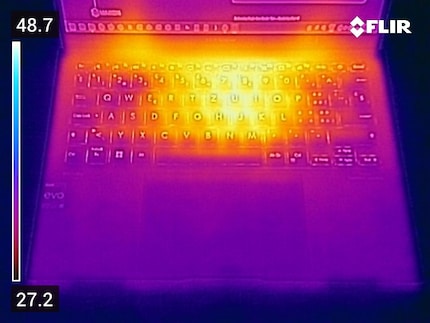
Source: Martin Jud
The processor core temperature briefly skyrockets to 92 degrees Celsius with Turbo during the Cinebench tests. However, it lowers quickly after that. On average, the CPU reaches 73 degrees Celsius during permanent load.
The case reaches a max of 48.7 degrees Celsius. However, the heat doesn’t spread – not all keys are suitable as finger warmers. Case temperatures in this range aren’t unusual during permanent load. Devices with more CPU cores can sometimes reach temperatures of over 50 degrees. When not under permanent load, the keyboard is usually at room temperature.
Verdict: a beautiful, small and well-designed device
Looking for a small and light notebook with a long enough battery life and a relatively strong processor? One that won’t be used for gaming, but for work and watching movies? Then the Asus Zenbook S 13 OLED will most likely satisfy. It delivers a solid performance with its SoC in my test. What’s cool is that its OLED display isn’t only convincing when streaming, but also when editing photos thanks to good coverage of the sRGB and AdobeRGB colour space.
Particularly worth mentioning, apart from a cooling system that fits the CPU, are the well-designed ports. Thunderbolt 4 (USB-C), USB Type-A plus HDMI 2.1 and audio ports are exactly what I usually need. The only thing I’m missing is a card reader, so don’t bin absolutely all your adapters.
If you look around for a notebook with similar equipment, you’ll quickly notice that the Zenbook is fairly priced considering the installed hardware. For example, the Lenovo ThinkPad X13 Gen 4 (Intel) with practically identical specifications costs about 400 francs more at time of writing.
Header image: Martin Jud
I find my muse in everything. When I don’t, I draw inspiration from daydreaming. After all, if you dream, you don’t sleep through life.
